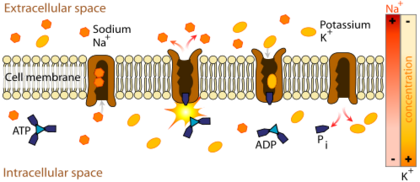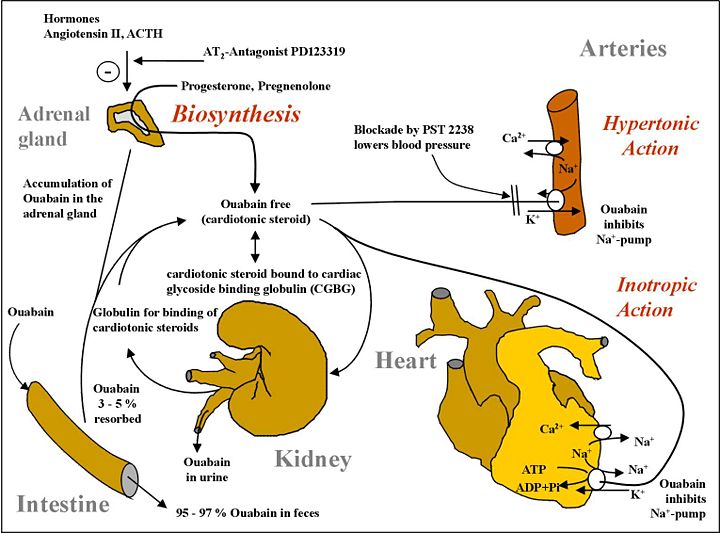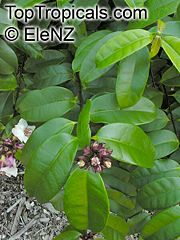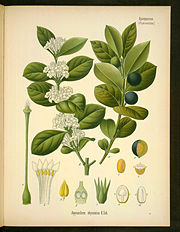Ouabain is a cardiac glycoside that inhibits ATP-dependent sodium-potassium exchange across cell membranes. The binding of ouabain to the sodium-potassium pump (also called Na+/K+ ATPase) prevents the conformational changes necessary for its proper function. This affects intracellular ion composition in various ways with various effects, depending on the cell and the dosage. The compound has therefore been utilized in medicine, both as a therapeutic and in research related to active active membrane transport.
Target Protein: Na+/K+ ATPase

Na+/K+ ATPase actively transports potassium into the cell and sodium to the extra-cellular space according to the general scheme depicted below. This transmembrane protein is composed of three subunits, alpha, beta, and gamma, that may dimerize with other pumps in vivo. The, crystal structure is a radially symmetrical hexamer, when in living tissues, the proteins most likely associate bilaterally. The alpha chain is shown in pink/blue and the beta chain in yellow/green. Of the two, the alpha subunit plays the leading role in the functioning of the protein. The bundle of alpha helices in the center of the protein position hydrophobic residues at the exterior of the motif, opening a portal through the lipid bilayer. It is inside this transmembrane domain that residues of the alpha subunit coordinate sodium or potassium ions. The large domain on the cytoplasmic side of the bilayer (furthest from beta subunit) floats in solution and is responsible for binding and hydrolyzing ATP. As with many protein enzymes of phosphoester hydrolysis, the phosphate groups are coordinated with a . The energy released from high-energy phosphate cleavage is transfered via conformational changes to the transmembrane domain, where ions are forced against their concentration gradient. On the extracellular side, the moves to prevent the dissociation of potassium ions during their entry into the cell. A third gamma subunit (purple/orange), along with the beta subunit, contributes to the anchoring of transmembrane domains to the phospholipid bilayer.
Normal functioning Na+/K+ ATPase changes unidirectionally between two phases, E1 and E2. In the E1 phase, it binds Na+ and ATP on the inside of the cell. After hydrolysis, the phosphorelated protein ejects ADP and changes conformation to E2, allowing for 3Na+ to dissociate on the extracellular side of the membrane. The protein then binds 2K+ and hydrolyzes the bound inorganic phosphate, causing the reversion to E1. Just before the binding of K+ to the E2 state, Ouabain binds to residues inside the pump, preventing the transition back to E1 (thus the magnesium cofactor is coordinating an enzymatically bound )
Ouabain Structure and Binding
Below is the structure of oubain in two dimensions. The molecule consists of a sugar bound to a modified cholesterol by a glycosidic linkage (hence
glycoside). The hydroxyl groups surrounding much of the molecule, along with the esters at either end, contribute to its binding to the membrane bound sodium-potassium pump. can also be seen in three dimensions. With the molecular geometry and stereochemistry displayed in this way, one can see more clearly the distribution of polar carbon-oxygen and non-polar carbon-carbon bonds in the space surrounding the molecule. This makes visualizing the binding of the inhibitor much easier. Ouabain is to the protein along the inside of an alpha-helix bundle. components of residues help somewhat in coordinating ouabain through Van der Waals forces, but residues, glutamine, aspartic acid, and threonine, along with the amide bond of an alanine, surround the hydroxyl and carbonyl groups of the ligand, forming hydrogen bonds of 2 to 4 angstroms in length. This not only holds the drug in place, but prevents conformational change necessary for the function of the protein.
Cardiac Muscle and Ion Pump Inhibition
The inhibition of Na+/K+ ATPase has indirect effects on the contractile strength, or inotrophy, of cardiac muscle cells. Through the increase in cytoplasmic sodium concentration, a sodium-calcium exchanger is activated, thereby increasing the cellular concentration of calcium. Calcium is a second messenger in many signaling/regulatory pathways. Its release into the cytoplasm of muscle cells signals contraction, explaining the positive effect of low doses of ouabain on cardiac introphy. The image below depicts this effect of all cardiac glycosides on myocardial tissue. As is shown, the inhibition of the sodium-potassium pump causes elevated cytoplasmic sodium, which activates the sodium-calcium pump causing in increase in cytoplasmic calcium. This increases the force with which the cell contracts.
If dosed correctly, ouabain proves to be effective in treating heart failure and arrhythmias. However, ouabain activity can indirectly contribute to the overloading of myocardial cells with sodium. Passive Na+ channels are usually inactivated when membrane potential is at its highest. When they re-open or fail to close, too much sodium can leak into the cell, causing the wasteful expenditure of ATP and/or uncoordinated muscle contraction. This is called late I-Na. With the rise of sodium and calcium, a Ca2+-calmodulin-dependent kinase is activated, in turn phosphorylating and activating passive Na+ channels. When the effects of ouabain are amplified in this way, the drug can cause more harm than good. Research has shown that an effective way to combat late I-Na is by the inhibition of the Ca2+-calmodulin-dependent kinase (Hoyer et al. 2011).







